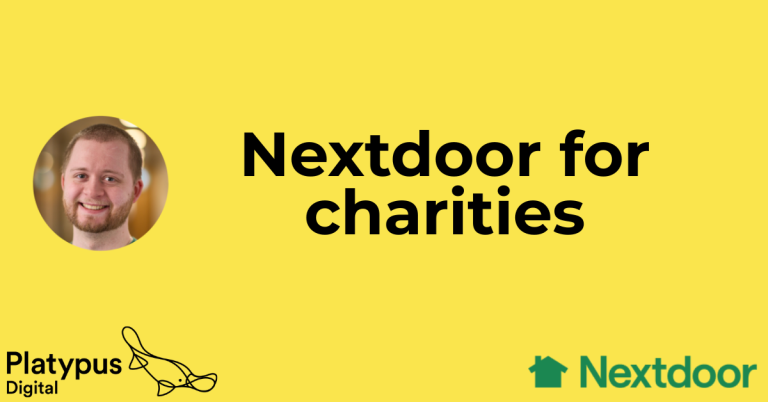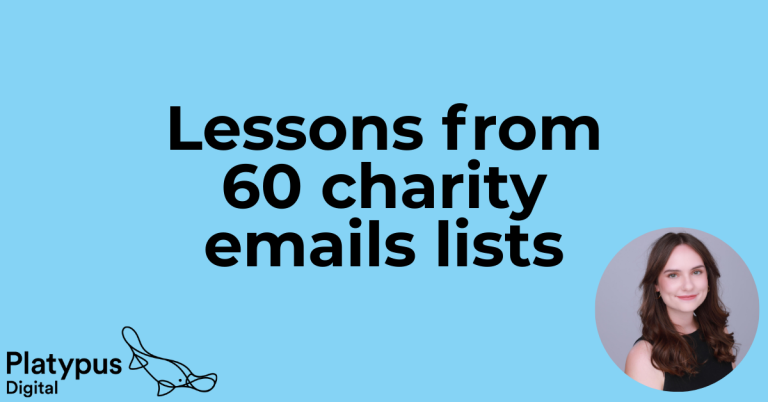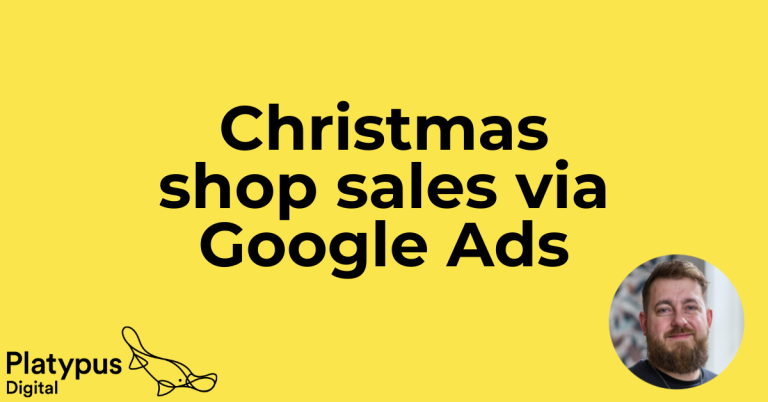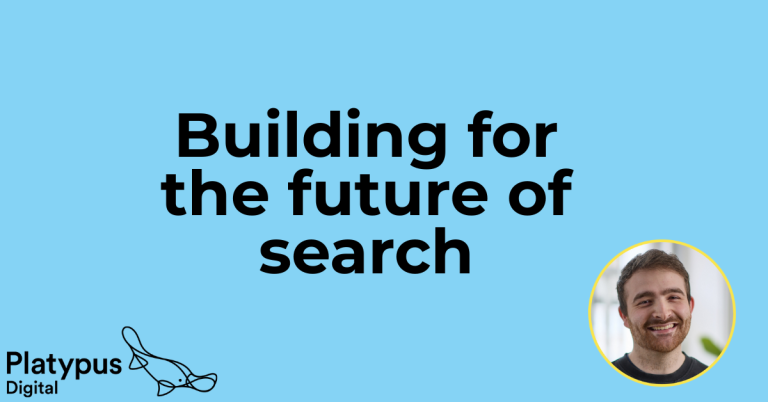Hyperlocal advertising
Nextdoor just launched its self service ad platform in the UK, meaning any business can set up, monitor, and optimise their own ads.
This is big news for charities.
If you haven’t heard of Nextdoor, it’s a social platform which caters to local communities, allowing ‘neighbours’ (users) to see content shared by people in their local area.
Previously, to run ads on Nextdoor, you’d need to bring a minimum media budget of £15k per campaign. This was because each campaign was managed in-house by an account manager. Spending this amount of money on a test campaign on an unproven platform is inaccessible for most charities, so take-up was low.
But Nextdoor has recently followed in the footsteps of Meta, Spotify, and LinkedIn, and switched over to a self-service model in the UK. That means no minimum spend, so anyone can use the platform to manage their ad setup. That’s really exciting news for charities who want to test this platform, but previously haven’t been able to afford it.
At Platypus, we ran a campaign for Dementia UK on Nextdoor, and we saw some really positive results.
So here’s an explainer of why and how to get started on Nextdoor!

Why should my charity advertise on Nextdoor?
I promise I’m no Nextdoor shill. But with what I can see across the paid social vertical, I would say that now is a great time to get into the Nextdoor ad market.
Here are a few reasons why.
Demographics match charities’ target audiences
Nextdoor’s users are a great match for the key demographics charities are often keen to target.
Over 55% of neighbours are over 55; they tend to be decision makers in the household, live in higher wealth areas, and the majority are homeowners. Given that the strongest group of givers for most charities is older folks with higher incomes, there’s a neat match here.
The most accurate geotargeting around
Meta will include users who are living in, visiting, or even just have an interest in a particular area in its geotargeting.
But Nextdoor requires users to verify their home address before they can access any content. This means it has the most accurate geotargeting of any search or social ad platform.
Nextdoor is by far the most effective way to reach users with locally-relevant calls to action. It’s perfect for local charities, or for larger organisations which have regionally specific events or opportunities.
Nextdoor has over 10 million users in the UK, and is used in a quarter of households across the country. So no matter where you are, there are bound to be neighbours around!

Low competition from other charities
Though some larger charities (like Médecins Sans Frontières, Shelter, and Battersea) have explored the use of Nextdoor over the last few years, uptake of ads on Nextdoor is low amongst charities.
Charities are generally more risk averse than businesses to get involved with new marketing channels, so there are only a few organisations actively advertising on the platform.
Since Nextdoor uses an ad auction like most social platforms, this means there’s likely to be less competition, and therefore cheaper advertising costs. This means now is a great time to test the platform and get some extra value outside of the crowded Meta ecosystem.
Merge fields in your area
Nextdoor’s regional data has opened up some useful opportunities for copywriting. Just like on LinkedIn, you can use location-based merge fields in Nextdoor ads, enabling the body text for an ad to be adjusted to include the name of a local town, city, or neighbourhood.
This allows your messaging to be hyperlocal, speaking to the relevant concerns and needs of your potential supporters through place names they recognise – something which most other platforms just can’t offer.
Conversion campaigns are available
Many health and finance charities have recently struggled to deliver lower-funnel paid campaigns through Meta, due to restrictions on their Meta pixel. If this is you, you may have been exploring lead generation campaigns, or looking to other platforms for acquisition opportunities.
Nextdoor is very well positioned to supplement or supplant these lower funnel Meta campaigns: there are no restrictions on its pixel use for conversion campaigns, and Neighbours are often in an high intent mindset when browsing the platform, as a significantly lower proportion of content is developed for “entertainment” purposes.
In summary, Nextdoor has a desirable demographic, strong targeting, and excellent opportunities for personalising your creatives, so now is a great time to get in on the ground floor.
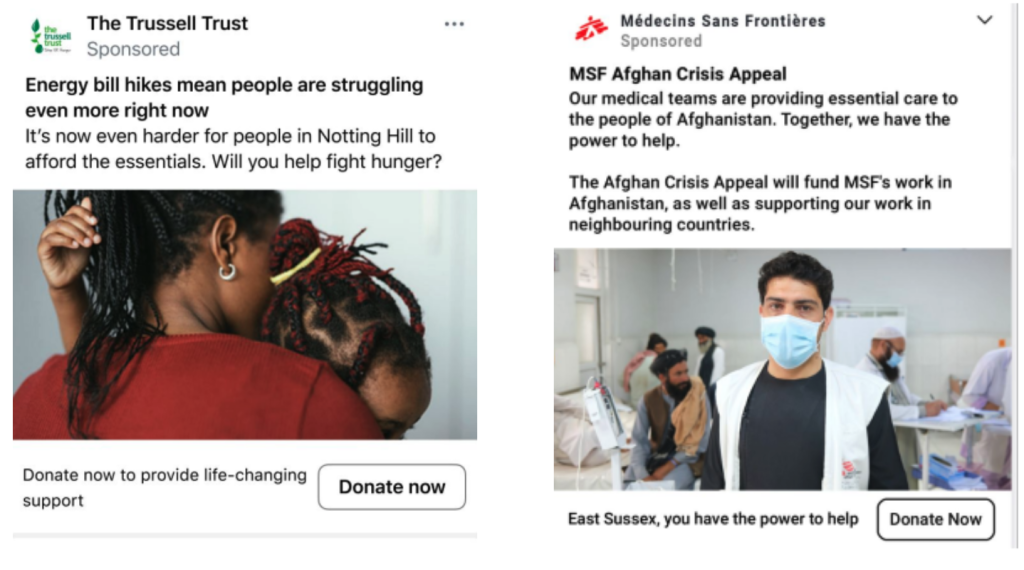
Limitations in tracking
Since the platform is relatively early in its development, some functions aren’t yet built out.
As of the time of writing, one gap in your options for tracking and targeting is custom conversions in the platform. These are available, but require hard-coding on your site, and without these, you’ll only be optimising for generic site-wide events. This means it’s worth pairing the in-platform results with Google Analytics data for a more detailed picture of your conversions.
How to get started
If you’re still reading, you must be feeling the need for hyperlocal advertising. So here’s how to get involved.
Set up a business account
Just like Meta, you’ll need a business account to access Nextdoor, but this is easy to set up through their ads manager. You can have multiple ad accounts attached to a single business, but each ad account can only be part of a single business.
Unlike Meta and other platforms, you don’t need an organic profile to advertise from – you can just start with the ads.
However, no matter your objective, you’ll also need to set up the Nextdoor pixel on your site, and potentially adjust your privacy policy to mention Nextdoor as a data processor, just like with other platforms.
Once you’ve sorted those out, you’re ready and locked in, and it’s time to send out your ads, from Stevenage to Stoke Newington!
Set up campaigns
Campaigns are structured like in Meta ads manager – the top level is a “campaign”, which defines budgets, objectives, and timelines; these contain “ad sets”, where you’ll select targeting and objectives; and then each “ad” specifies the copy, visuals, and outbound link.
The available objectives are fairly broad:
- Brand Awareness
- Website Visits
- Lead Generation (website only- on-platform lead generation forms aren’t currently available in the UK, but you can direct users to an on-website lead generation form)
- Conversion

Audience targeting options also reflect how things work on Meta: as well as the standard demographic and interest targeting options, you can use Nextdoor’s location tools to reach users by county, city, town, or postcode. You can also exclude or include custom audiences, though there aren’t any Lookalike audiences in the platform yet.
You can set separate budgets and timelines for each ad set, define a maximum bid per impression or click, and even set a frequency cap for your reach-focused campaigns. You’ll also determine placements from the three options (Newsfeed, For Sale & Free, Right Hand-Rail).
Finally, at the ad level, you’ll probably make a few ads per ad set. You’ll have to decide between image, video, and carousel formats. You’ll supply the creative, and this will have to be approved by Nextdoor.
All of this is housed in a robust and simple user experience, which is much simpler than Meta’s Ads Manager, given that the Nextdoor platform has only been around a short while. The setup should be pretty familiar to users of Meta or other self-service paid social platforms, so there’s nothing scary to put you off!
Next steps for your charity
So there you have it – a complete guide to how your charity can run Nextdoor Ads and why you would want to.
Register for a business account, set up some campaigns and away you go.
Thinking about running NextDoor ads, but feeling like you need a little help? Get in touch!
Other posts you might enjoy
✍️ Meta’s EU political ad ban: what it means for charities

